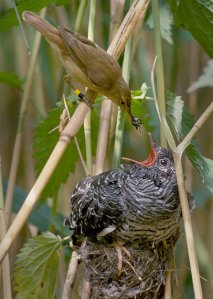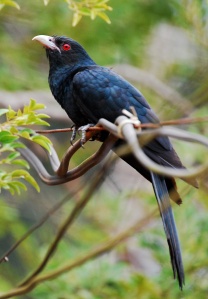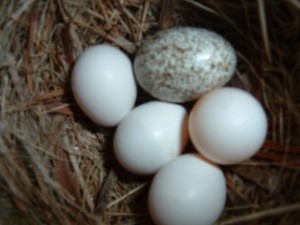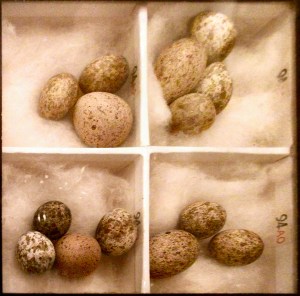Today is Mothering Sunday which made me think about all the lovely Mummies in the animal kingdom. For our furry, feathery and slimy friends, child care can take many forms. In fact, in the animal kingdom caring for your children is not always a requirement. Some animals, such as penguins, keep a watchful eye over their young until they are capable of taking care of themselves. But others aren’t so attentive. One particularly interesting example of animals with a more relaxed parenting style are the brood parasites – and my particular favourite are the birds.
Brood parasitic birds have removed their childcare responsibilities all together by laying their eggs in the nests of other birds. (Note: the word ‘parasite’ usually makes people think of small, creepy bugs, but try and refrain from picturing these in this case. Here the parasite is the bird trying to lay its eggs in another bird’s nest, otherwise called the host). Think of it as hiring a nanny but without telling them or paying them for the service! To us, this behaviour might seem slightly heartless, but for the brood parasite it’s a great strategy! Sparing yourself the expense of rearing your own child means you can focus your energy on other things. You have the time and resources to find new mates and make even more eggs, instead of having to defend your nests, incubate your eggs and feed your demanding chicks.
For the bird that’s left to bring up someone else’s young however, the story is very different. In many cases the brood parasite will not only lay their egg in another nest, but will also remove one of the host’s eggs to do so! Even when no egg is removed the host’s young are still affected, due to competition with the larger, more aggressive parasitic young. Some parasitic chicks will even use a sharp spike on the end of their beak to crack the other eggs or even to brutally attack other chicks.
Obviously, the host bird has no interest in raising someone else’s child and so will do its best to make sure it doesn’t become a victim of these parasites. This leads to the development of something called a coevolutionary arms race. This basically means the host finds new ways to prevent itself becoming a victim of the parasite. Of course this just causes the parasite to develop her own ways of tricking the host into becoming her own personal nanny. This cycle has gone round and round in circles for centuries which means the birds have developed lots of neat (and pretty impressive) little ways to get their own way. Let the battle commence.

In the red corner, the Brood Parasite
Brood parasites can lay their eggs in the nests of birds from their own species or from a completely different species altogether. Some will only parasitize a single host whilst others will parasitise a large range of different species – for example, the Brown-headed Cowbird has over 200 known hosts! Laying your eggs in the nest of a female of another species has its problems – surely a Reed Warbler will notice when a baby Common Cuckoo hatches from one of the eggs it has been tending so lovingly? If a host realises an egg has been placed in its nest, it will remove it straight away. There are several ways the parasite can try and stop this from happening…
It’s all in the timing
To begin with, you have to get your timings right. It’s no good laying your egg in the nest of a bird that hasn’t started laying her own eggs yet – she’s bound to notice! Studies have shown that parasites adjust their laying pattern to complement their hosts. Although parasites need to lay late enough so their eggs aren’t immediately rejected, they also want their young to hatch first – this means finding the perfect balance between the two. Many brood parasites have very short egg incubation periods and rapid chicks growth, giving them competitive edge over their new nestmates.

In some species the males provide the females with a partner in crime. Male Asian koels will distract female crows away from their nests to allow their partner to sneak to the crow’s nest. Finding your opportunity can be tricky and once you’ve got it you can’t hang around at your hosts nest waiting to be spotted – otherwise your freshly laid egg isn’t going to last long. Parasites have therefore adjusted the time it takes for them to lay their eggs, often only taking mere seconds to pop one out, meaning they can be in and out before the host notices.
Egg Mimicry

Getting your egg into a hosts nest is not where the story ends. Bird eggs come in all different shapes, sizes and colours so a host can often spot an imposter. This has led to the development of egg mimics. Here the parasite makes their eggs look as similar to the hosts as possible. This is particularly apparent in birds that parasitise specific hosts, as they can invest the time and effort needed into perfecting a mimic good enough to fool their host. Studies have shown that all this effort to disguise your eggs is worth it – eggs that more closely resemble the hosts are much less likely to be rejected!

In the blue corner, the Host
For the host it is definitely best to detect an intruder before you’ve invested precious energy caring for their egg. Fighting off potential parasites is a start, but you must have a game plan for those birds that manage to sneak an egg past you. Recognising your own eggs is a good place to start and evidence shows that hosts are able to do this. If the host does spot an intruder, she will remove it from her nest. Occasionally some hosts will completely abandon the nest – but this will only happen if the cost of finding a new mate, building a new nest and laying a new clutch is not too high.
Accidentally rejecting your own chick is a big problem for the host. If hosts struggle to identify their own egg, rejecting a suspected host at the egg stage can sometimes be too costly – just in case you accidentally destroy one of your own eggs. Birds who fall victim to brood parasitism will often lay lots of eggs because of this – the more eggs you lay the more back-ups you have if you do accidentally destroy one of your own. In these cases learning to recognise your chicks may also be a good strategy. This involves learning to recognise the plumage patterns, begging calls and mouths of your own chicks – as the inside of some chicks beaks have distinctive patterns.
This battle doesn’t really have a clear winner. Once one opponent finds a way to take the lead, you can almost guarantee it won’t be long until the other has found a way to edge back in front. The struggle for survival means both birds will fight and fight until they are crowned the champion.
It might seem like an unusual strategy but having their own free nanny service has allowed many bird species to thrive. Just think of the cruises your parents could have gone on if someone else had paid for your upkeep!
